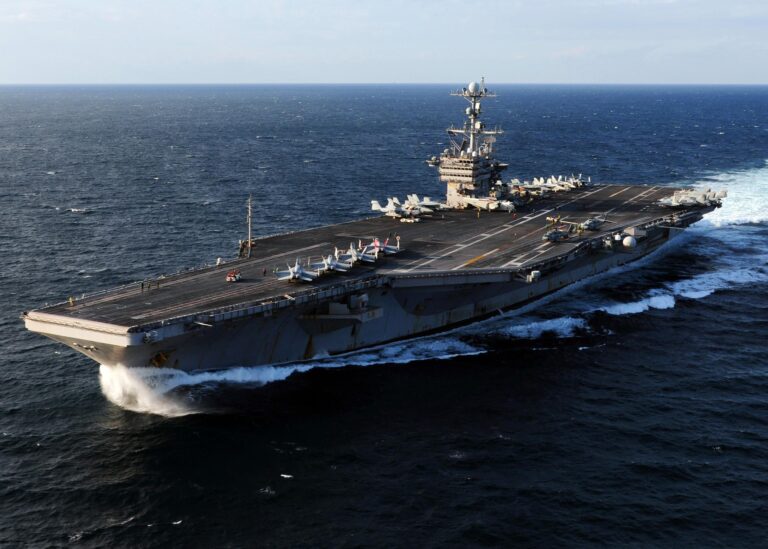US and UK Aircraft Carriers Unite for Strategic Naval Exercises Near Australia
Collaborative Naval Operations: USS George Washington and HMS Prince of Wales in Australian Waters
Demonstrating a powerful alliance, the United States Navy’s USS George Washington and the Royal Navy’s HMS Prince of Wales recently conducted coordinated naval exercises off Australia’s coastline. This joint operation highlights the deep-rooted partnership between the US and UK, focusing on strengthening maritime security and operational compatibility within the Indo-Pacific theater. Both carriers, outfitted with state-of-the-art technology and formidable air wings, engaged in a variety of complex drills such as coordinated flight operations, tactical combat simulations, and underway replenishment procedures. These activities reinforce their mutual dedication to preserving a free and open Indo-Pacific amid shifting geopolitical tensions.
Noteworthy components of the exercises included:
- Integrated strike missions featuring F-35 stealth fighters and other carrier-based aircraft
- Joint air defense scenarios to enhance threat detection and rapid response capabilities
- Secure real-time communication and data exchange between allied command centers
- Combined search and rescue operations to boost crew safety and mission readiness
| Carrier | Aircraft Capacity | Displacement | Home Base |
|---|---|---|---|
| USS George Washington (CVN-73) | Approximately 75 aircraft | 97,000 tons | Yokosuka, Japan |
| HMS Prince of Wales (R09) | Around 40 aircraft | 65,000 tons | Portsmouth, United Kingdom |
This naval collaboration not only enhances tactical proficiency but also fosters deeper mutual understanding, preparing both navies for future joint missions throughout the Indo-Pacific and beyond.
Strategic Impact of US-UK Carrier Synergy in the Indo-Pacific
The joint deployment of USS George Washington and HMS Prince of Wales represents a significant evolution in allied naval presence in the Indo-Pacific region. This partnership projects a unified stance amid increasing regional security complexities, enhancing maritime situational awareness and reinforcing deterrence against potential adversaries. Through synchronized carrier strike group operations near Australia, these vessels exemplify their ability to uphold freedom of navigation and support the international rules-based order.
The strategic advantages of this collaboration include:
- Amplified Combat Power: The combined air wings enable swift, adaptable responses to emerging threats.
- Improved Operational Cohesion: Real-time coordination sharpens joint tactics, communication, and logistical support.
- Strengthened Regional Deterrence: The visible alliance discourages hostile actions and reinforces defense partnerships with Indo-Pacific nations.
| Capability | USS George Washington | HMS Prince of Wales |
|---|---|---|
| Air Wing Size | 75+ aircraft | 40+ aircraft |
| Flight Deck Length | 332 meters | 280 meters |
| Top Speed | Over 30 knots | Over 30 knots |
| Displacement | 97,000 tons | 65,000 tons |
Advancing Interoperability Through Joint Training Exercises
Emphasizing their dedication to collective defense and operational excellence, the US and UK navies executed extensive joint drills off the Australian coast. These exercises focused on seamless integration between USS George Washington and HMS Prince of Wales, enhancing tactical interoperability across air, sea, and command operations. Crew members engaged in synchronized flight deck procedures, communication protocols, and coordinated air defense tactics, ensuring both carriers can function as a unified force in diverse conflict scenarios.
Core components of the training included:
- Coordinated launch and recovery of air wing assets
- Secure, real-time data sharing through encrypted communication networks
- Joint anti-submarine warfare (ASW) drills to counter underwater threats
- Cross-deck helicopter operations facilitating personnel and equipment transfers
This enhanced cooperation not only boosts immediate operational readiness but also cultivates long-term partnerships vital for maintaining regional security. By training under varied scenarios, both navies improve their adaptability to emerging maritime challenges.
| Exercise Element | USS George Washington | HMS Prince of Wales |
|---|---|---|
| Aircraft Sorties | 35 | 38 |
| Helicopter Cross-Deck Transfers | 12 | 12 |
| Communication Drills | 5 sessions | 5 sessions |
| Simulated ASW Engagements | 3 | 4 |
Recommendations for Enhancing Multinational Naval Cooperation in Future Exercises
To further elevate the effectiveness of allied naval collaborations, prioritizing real-time communication interoperability is essential. Adopting standardized communication frameworks and investing in cutting-edge secure data-sharing technologies will enable vessels like USS George Washington and HMS Prince of Wales to coordinate complex tactical operations and logistical support with minimal delay and confusion during high-pressure situations.
Additionally, incorporating cross-deck training and joint command simulations prior to deployments can deepen mutual understanding of operational doctrines and equipment capabilities. Promoting cultural exchanges and leadership rotations during these preparatory phases will build trust and responsiveness among crews, ultimately enhancing the collective readiness of multinational naval task forces confronting dynamic maritime threats.
- Standardize communication protocols to ensure rapid, secure information exchange.
- Expand pre-deployment joint training focusing on interoperability and command integration.
- Encourage leadership exchange programs to foster cultural and operational insight.
- Invest in shared simulation platforms to rehearse complex multinational scenarios.
| Focus Area | Recommended Action | Anticipated Outcome |
|---|---|---|
| Communication | Unified protocols | Accelerated information flow |
| Training | Cross-deck exercises | Enhanced teamwork |
| Leadership | Exchange initiatives | Strengthened trust |
| Simulations | Advanced joint drills | Improved operational readiness |
Conclusion: A Unified Naval Front for Indo-Pacific Stability
The recent joint operations between USS George Washington and HMS Prince of Wales off Australia’s coast exemplify the enduring strength and interoperability of US and UK naval forces. As geopolitical landscapes continue to shift in the Indo-Pacific, such collaborative endeavors reaffirm a shared dedication to safeguarding maritime security and regional stability. Future deployments will be closely observed to evaluate how these partnerships evolve in response to emerging global challenges.







